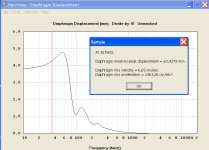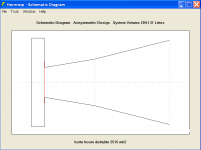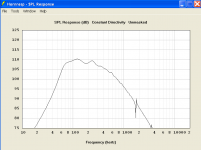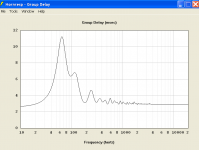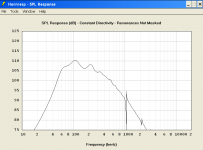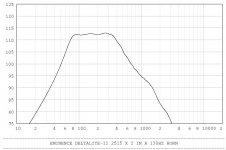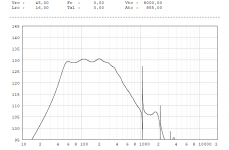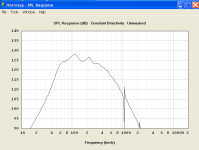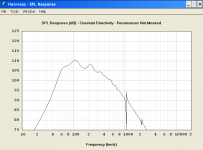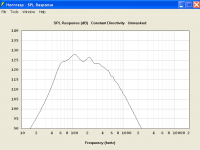I'm sure it's a great idea to horn load the harmonic distortion and other noise the driver creates at nigh excursion.
I thought the idea of a horn was to minimize cone excursion by increasing the apparent impedance of the air.
That true and you will still have that advantage. the cone extrusion above 65Hz will be very low.
And the high extrusion only occurs with high level subbas. I haven't tried it so that shout prove it self when actual build this way. With a DSP you can do what you like If it doesn't sound good you turn it low again.
If you think it is a problem you can do even the same with extra BR-loading of the closed volume, then you control the x-max till the BR-loading is gone.
And it is depending on what kind of music you like to listen.
It is a simple choice make it with out correction maintain low extrusion and never hear sub-bas.
Or tollerate higher extrusion on passages with sub-bass the side effects can't be heard due high sound level I reckon. And have best of both worlds clear mid range with out sacrificing sub-bas.
Last edited:
The harmonic distorsion with the active correction isn't worse as with a normal closed box. And the driver still got some horn loading and will even perform a bit better than in a normal sealed box.
The harmonic distorsion level will likely increase with more correction so at 35Hz more then at 65Hz.
So the second harmonic will be 70Hz and the third harmonic 105Hz. It is a good point made by David web this active correction is done by open baffle designs due their poor efficiency this is thd increase is a real problem.
In this case with the horn loading and a 15" driver with low distortion I estimate it will perform still good even with active correction.
For example when listening at louder level as high as 90dB 1meter we have a extrusion of 0,42mm. For higher frequencies the extrusion will decrease rapidly. For example at 65Hz the extrusion at 90dB is 0,0733mm.
The harmonic distorsion level will likely increase with more correction so at 35Hz more then at 65Hz.
So the second harmonic will be 70Hz and the third harmonic 105Hz. It is a good point made by David web this active correction is done by open baffle designs due their poor efficiency this is thd increase is a real problem.
In this case with the horn loading and a 15" driver with low distortion I estimate it will perform still good even with active correction.
For example when listening at louder level as high as 90dB 1meter we have a extrusion of 0,42mm. For higher frequencies the extrusion will decrease rapidly. For example at 65Hz the extrusion at 90dB is 0,0733mm.
Attachments
Last edited:
I do have the MiniDSP, so I can give this a try. But first I will have to build the front horns. My friend John who is here on diyaudio has designed a front horn for me with a -3db at 72 Hz. It is with the Eminance Deltalite 2515 driver.
That would be great ra7!
The Delta 2515 has to be in a sealed enclosure to work this way with active correction. So not in a BR-enclosure.
The deltalite has a xmax of 4,8mm linear extrusion mechanical limit 9mm(the 18sound has 6,5mm).
It would be nice to see THD at 1W without correction and with correction.
With cut of at 73Hz I would correct it down to 45Hz other wise it will be to huge for the woofer. you could try also 50Hz to compare.
I am also interested what the influence is sound-wise and possible side effects you notice.
Yup, it should be interesting to see if the woofer can handle it. 45 to 50 Hz is probably a good idea. In room, it should sound deeper than that, atleast that has been my experience.
Yes, it is a sealed enclose with a front horn. The efficiency from 72 to 500 Hz is 110db/W and it is ruler flat in that region (Hornresp).
I need to build it first though. It will be my first front horn ever, so it's going to take a while.
John suggests going for a folded bass horn for subbass duty, but there is no space in the current living room... maybe one for the future.
Yes, it is a sealed enclose with a front horn. The efficiency from 72 to 500 Hz is 110db/W and it is ruler flat in that region (Hornresp).
I need to build it first though. It will be my first front horn ever, so it's going to take a while.
John suggests going for a folded bass horn for subbass duty, but there is no space in the current living room... maybe one for the future.
I did place the deltalite in my 1 meter horn almost the same result as the 18sound -3dB at 66Hz 1phi. At 0,5 phi -3dB at 60Hz. Group delay of the 18 sound is better.
The delta-lite has a sharp price tag dough.
The delta-lite has a sharp price tag dough.
Attachments
Last edited:
The beyma sn115n is also very nice 118 euro ex. And 5,5mm xmax so for who want to correct active a very good choice. 15mm mechanically x-max. And very low thd figures.
http://profesional.beyma.com/pdf/SM-115%20NE.pdf
http://profesional.beyma.com/pdf/SM-115%20NE.pdf
OT - but I must say, the weirdest sound I have heard presented as 'hifi' was a pair of Klipsch Jubilee (at the UK Heathrow show 2 years ago). It was actively driven with some (no doubt very expensive 3w/ch SETs, with crossovers done with DSP.
Walking into the room it sounded like a small AM radio playing , with a nightclub next door doing the bassline: deeply, deeply flawed. But after about 5mins my brain suddenly 'got it' after which it was immense fun. Played a few more discs. It remains the most physical presentation of Aphex Twin's 'Bucephalus Bouncing Ball' I've ever heard...
Walking into the room it sounded like a small AM radio playing , with a nightclub next door doing the bassline: deeply, deeply flawed. But after about 5mins my brain suddenly 'got it' after which it was immense fun. Played a few more discs. It remains the most physical presentation of Aphex Twin's 'Bucephalus Bouncing Ball' I've ever heard...
Walking into the room it sounded like a small AM radio playing , with a nightclub next door doing the bassline: deeply, deeply flawed. But after about 5mins my brain suddenly 'got it' after which it was immense fun. Played a few more discs. It remains the most physical presentation of Aphex Twin's 'Bucephalus Bouncing Ball' I've ever heard...
A horn makes transparent low response loose from the box it sounds powerfull and behind the singer. For what I experienced with my backloaded horns.
Speakers with a bad impulse can't do that, but can sound wise have a fat bass and be much fun but never so clear and spacious as a horn-loaded one.
Last edited:
One clever advantage of a front basshorn (despite the title of the thread) is steep attenuation of distortion harmonics and breakup products from the cone of the bass driver. Crossovers attenuate electrical power going into the driver, but do not attenuate distortion products radiating off the cone. That's where a folded or curved front horn can be useful, since it acoustically lowpass filters the distortion products, and well as mid and high-frequency cone breakup.
One clear difference between a front horn and an equivalent-efficiency direct-radiator driver array would be the acoustical lowpass filtering of the front horn. The trick is to arrange the folds and/or curves so they assist the lowpass crossover design, instead of working against it.
One clear difference between a front horn and an equivalent-efficiency direct-radiator driver array would be the acoustical lowpass filtering of the front horn. The trick is to arrange the folds and/or curves so they assist the lowpass crossover design, instead of working against it.
Last edited:
Hi Lynn,
http://www.diyaudio.com/forums/multi-way/137036-big-bandpass-fatboy.html
To have that advantage I made a bandpass system. It had by listening to it low distorsion but not as super tight as a hornloaded driver. There for it had a warm sound and deep subbass.One clever advantage of a front basshorn (despite the title of the thread) is steep attenuation of distortion harmonics and breakup products from the cone of the bass driver. Crossovers attenuate electrical power going into the driver, but do not attenuate distortion products radiating off the cone. That's where a folded or curved front horn can be useful, since it acoustically lowpass filters the distortion products, and well as mid and high-frequency cone breakup.
http://www.diyaudio.com/forums/multi-way/137036-big-bandpass-fatboy.html
What are you thinking about Lynn, Do you want to create a opposite phase at crossover frequency?One clear difference between a front horn and an equivalent-efficiency direct-radiator driver array would be the acoustical lowpass filtering of the front horn. The trick is to arrange the folds and/or curves so they assist the lowpass crossover design, instead of working against it.
What are you thinking about Lynn, do you want to create a opposite phase at crossover frequency?
No, not at all. Notches in the frequency response anywhere near the crossover frequency are extremely undesirable. They make the crossover design nearly impossible, since notches do not lend themselves to equalization.
What would be desirable would be a smooth acoustic rolloff with no notches at all. That's why I'm curious about curved horns - would they have less problem with notches than a folded horn, or not?
No, not at all. Notches in the frequency response anywhere near the crossover frequency are extremely undesirable. They make the crossover design nearly impossible, since notches do not lend themselves to equalization.
What would be desirable would be a smooth acoustic rolloff with no notches at all. That's why I'm curious about curved horns - would they have less problem with notches than a folded horn, or not?
In simulation a soft hung woofer tends to roll off early but react more on on equal acoustic resistance of the horn the spl dances along with the resistance of the horn. So less flat
Horn response does calculate standing-waves of the sealed volume as you will know.
I think the longer the horn to the higher the frequency is undesirable. like here the 1meter horn with only 1 fold the Klipsch La Scala design. Will perform perfect up to 150Hz the first part is average 45cm and the second part 65cm.
I wanted to simulate a soft-hung woofer but horn-response is working anymore.
Ok hornresp running again.
Here the result 1 phi -3dB at 250hz.
This driver.
MONACOR INTERNATIONAL roduktdetailseite IMG Stage Line
roduktdetailseite IMG Stage Line
Here the result 1 phi -3dB at 250hz.
This driver.
MONACOR INTERNATIONAL
Attachments
Helmuth and Lynn,
Here's the simulated response of the Eminence Deltalite 2515 in a front horn.
Don't ask me anything about the simulation. I did not do it, but I can get John
to perhaps comment here.
Nice roll off beyond 400 Hz. Exactly what Lynn wanted I think. John tells me
that the little throat before the expansion is key.
Here's the simulated response of the Eminence Deltalite 2515 in a front horn.
Don't ask me anything about the simulation. I did not do it, but I can get John
to perhaps comment here.
Nice roll off beyond 400 Hz. Exactly what Lynn wanted I think. John tells me
that the little throat before the expansion is key.
Attachments
Here the result 1 phi -3dB at 250hz.
Does this include its on axis rising response prediction?
GM
Looks ver nice flat ra7 (depending on if it is 0,5-1-2phi) he did place a volume for the cone to design the roll off. And yes the throat that is one of the key variables to play with reducing the throat gives a more linieair acoustic resistance but a small throat limits the low end.Helmuth and Lynn,
Here's the simulated response of the Eminence Deltalite 2515 in a front horn.
Don't ask me anything about the simulation. I did not do it, but I can get John
to perhaps comment here.
Nice roll off beyond 400 Hz. Exactly what Lynn wanted I think. John tells me
that the little throat before the expansion is key.
But why would one want to have that when a filter is used then in fact it is more a disadvantage for linearity.
I reduce that effect to the minimum to have extended response.
Here I did the same with my latest find this one does 50Hz-450Hz 1meter la scala horn and i added a front chamber to get the roll off. 0,5 phi
Attachments
Last edited:
Does this include its on axis rising response prediction?
GM
It is the predicted response from the mouth output, you could use it to have the axes rising compensated.
Like with the previous post with the front chamber (Vtc in hornresp) you could even play with the steepness of the response.
The extended response is with front chamber the falling response is the same horn with no front chamber.
Attachments
Last edited:
It is the predicted response from the mouth output, you could use it to have the axes rising compensated.
Like with the previous post with the front chamber (Vtc in hornresp) you could even play with the steepness of the response.
Could you post a picture of the input screen?
Frode
Could you post a picture of the input screen?
Frode
input screen of the monacor spa15pa. The peeks at the 1kHz area can be reduced by reducing Lrc (the maximum length in the sealed enclosure) see result c.
Attachments
Last edited:
- Status
- This old topic is closed. If you want to reopen this topic, contact a moderator using the "Report Post" button.
- Home
- Loudspeakers
- Multi-Way
- Back Loaded Horns
